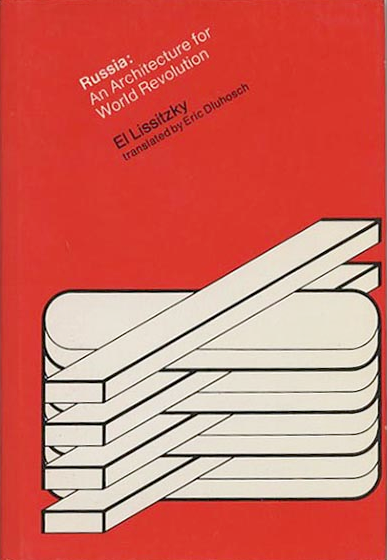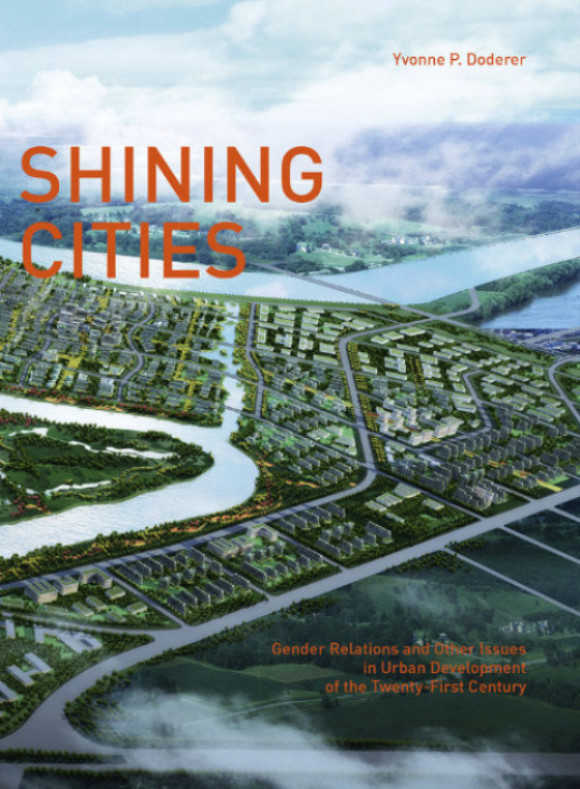El Lissitzky: Russia: An Architecture for World Revolution (1930–) [German, English]
Filed under book | Tags: · architecture, city, russia, soviet union, urban planning

” El Lissitzky ‘s book is a classic in architectural and planning theory, as well as an important document in social and intellectual history. It contains an appendix of excerpted writings by his contemporaries – M. J. Ginzburg, P. Martell, Bruno Taut, Ernst May, M. Ilyin, Wilm Stein, Martin Wagner, Hannes Meyer, Hans Schmidt, and others – all of whom illuminate the architecture and planning of Europe and Russia during the 1920s. There are over 100 plates and drawings.”
First published as Russland. Die Rekonstruktion der Architektur in der Sowjetunion, Anton Schroll, Vienna, 1930.
New edition
Edited by Ulrich Conrads with Dietrich Helms
Ullstein, Berlin, 1965
Ullstein Bauwelt Fundamente series, 14
206 pages
English edition
Translated by Eric Dluhosch
Publisher MIT Press, November 1970
ISBN 0262120348
239 pages
Reviews: Albert J. Schmidt (Slavic Review, 1971), E.B. (J European Studies, 1971).
Russland. Die Rekonstruktion der Architektur in der Sowjetunion (German, 1930/1965, 12 MB)
Russia: An Architecture for World Revolution (English, 1970, 24 MB)
Yvonne P. Doderer: Shining Cities: Gender Relations and Other Issues in Urban Development of the Twenty-First Century (2016)
Filed under book | Tags: · city, feminism, gender, queer, urban planning, urbanism

“In the twenty-first century, the majority of people are living in cities—at least this is the credo communicated frequently. This statement has been strengthened by the “urban renaissance” that dawned at the beginning of the twenty-first century and by a globally evident increase in capital investment in urban-development projects. Such planning endeavors are conveyed to the public, the political sphere, and the media with the help of Internet platforms. The visualizations and descriptions found on such project websites are associated with promises of modernization, appeal, and economic growth—in short, with a better life.
In this publication, images and texts from 12 projects planned for Europe, Africa, and Asia are surveyed critically: What do they “tell” about future life in these new urban districts? Who will live and work in these cities? Which forms of living and lifestyles are propagated? And most importantly: How do these designs relate to actual urban reality, including that of the inhabitants to whom the projects are addressed?
Written in a comprehensible way, supplemented by illustrations and photographs, this in-depth analysis sensitizes the reader to the interconnections between urban-space production and societal (gender) relations.”
Self-published, 2016
Digital Peer Publishing Licence (DPPL)
ISBN 9783000550188
321 pages
Ravi Sundaram: Pirate Modernity: Delhi’s Media Urbanism (2009)
Filed under book | Tags: · city, delhi, globalisation, infrastructure, mass media, modernism, modernity, piracy, postcolonialism, urban planning, urban studies, urbanism

“Using Delhi’s contemporary history as a site for reflection, Pirate Modernity moves from a detailed discussion of the technocratic design of the city by US planners in the 1950s, to the massive expansions after 1977, culminating in the urban crisis of the 1990s.
As a practice, pirate modernity is an illicit form of urban globalization. Poorer urban populations increasingly inhabit non-legal spheres: unauthorized neighborhoods, squatter camps and bypass legal technological infrastructures (media, electricity). This pirate culture produces a significant enabling resource for subaltern populations unable to enter the legal city. Equally, this is an unstable world, bringing subaltern populations into the harsh glare of permanent technological visibility, and attacks by urban elites, courts and visceral media industries. The book examines contemporary Delhi from some of these sites: the unmaking of the citys modernist planning design, new technological urban networks that bypass states and corporations, and the tragic experience of the road accident terrifyingly enhanced by technological culture. Pirate Modernity moves between past and present, along with debates in Asia, Africa and Latin America on urbanism, media culture, and everyday life.
This pioneering book suggests cities have to be revisited afresh after proliferating media culture. Pirate Modernity boldly draws from urban and cultural theory to open a new agenda for a world after media urbanism.”
Publisher Routledge, Oxford & New York, 2009
Asia’s Transformations series
ISBN 9780415409667, 0415409667
xix+224 pages
HT Geraldine
Reviews: Diya Mehra (SAMAJ, 2011), Fei An Tjan (Masters of Media, 2010).
PDF (10 MB)
Comment (0)
